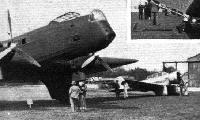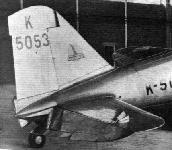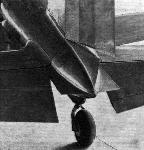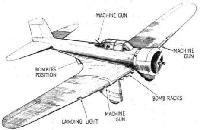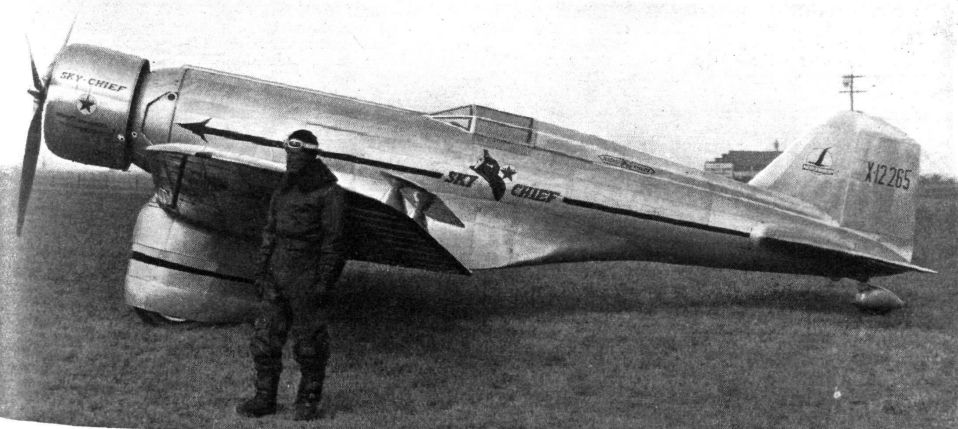
Варианты
- Northrop - Gamma / A-13 / A-16 - 1932 - США
- Northrop - A-17 / 8A Nomad - 1934 - США
Northrop Gamma
В январе 1932 года Джон Нортроп и Дональд Дуглас основали на паях корпорацию "Northrop Corporation" как дочернее подразделение компании "Douglas Aircraft Со.". Первым самолетом новой компании стал Northrop Gamma - несколько машин были построены для совершения рекордных перелетов и исследований. Первые два самолета - Gamma 2A и Gamma 2B - были оснащены звездообразными двигателями Wright мощностью 785 л.с. и Pratt & Whitney Wasp мощностью 500 л.с., соответственно. Обе машины были поставлены в конце 1932 года: первый - компании "Texaco", передавшей его в аренду Фрэнку Хоксу для совершения рекордных полетов; второй - в аренду Линкольну Эллсворту, совершившему на нем трансантарктический перелет. Компания TWA в 1934 году приобрела три самолета Gamma 2D с двигателями Wright Cyclone мощностью 710 л. с. для использования в качестве одноместных почтовых самолетов. На втором был позднее установлен двигатель Wright мощностью 775 л. с. - самолет использовался компанией "Texaco" для измерения температуры масла и летал до тех пор, пока не был продан в авиакорпус Армии США, где получил обозначение UC-100.
Несколько самолетов Gamma были поставлены частным покупателям, включая два самолета, проданных в Великобританию, самолет Gamma 2E передали в Экспериментальный центр авиации и авиационного вооружения британских ВВС, а последний построенный самолет Gamma 2L - компании "Bristol Aeroplane Со.", где он использовался в качестве летающей лаборатории для отработки двигателей Hercules. Правительство Китая заказало 24 самолета Gamma 2E для использования в качестве легких бомбардировщиков - они оснащались двигателями Wright мощностью 710 л. с. и могли брать на борт 726 кг бомб, а вооружение включало четыре 7,62-мм пулемета в крыле и один пулемет в задней кабине для обороны задней полусферы. Еще 25 самолетов Gamma 2E были собраны в Китае из комплектующих, поставленных компанией-разработчиком.
Описание:
- Northrop Gamma
- Northrop A-13, A-16, A-17 и A-33
- Flight, February 1935
A 200 m.p.h. BOMBER
Фотографии
-
Flight 1933-08 / Flight
Регистрационный номер: X12265 [2] "THE HUMAN BULLET": Frank Hawks, of "Texaco," and his all-metal Northrop "Gamma" Sky-Chief, on which he made his 200 m.p.h. flight across Canada.
-
Jane's All the World Aircraft 1980 / Encyclopedia of Aviation - Aircraft A-Z - v5
Регистрационный номер: X12265 [2] First Northrop Gamma
-
Aviation Historian 12 / E.Young - Over the Weather
Регистрационный номер: NC13758 [7], NX13758 [7] Gamma 2D использовался для экспериментов на больших высотах, чтобы выяснить возможность авиалайнеров обходить грозовые фронты.
Northrop 2D Gamma NC13758 before its modification for use in Tomlinson’s high-altitude research programme. All three examples of the 2D Gamma were purchased by TWA for a high-speed mail service that never fully materialised in the wake of the 1934 Air Mail Emergency, when the US Army took over the transport of the nation’s air mail - temporarily, as it turned out. -
Aviation Historian 12 / E.Young - Over the Weather
Регистрационный номер: NX13758 [7], NC13758 [7] This side view of the Gamma clearly shows the rectangular turbocharger installation on the port side of the engine cowling. Despite the type’s chronic shortcomings in terms of the view from the cockpit, the Gamma was classically brawny in the American tradition, and was reportedly much-loved by its pilots, who found it strong and steady.
-
Aviation Historian 12 / E.Young - Over the Weather
Регистрационный номер: NX13758 [7], NC13758 [7] Tomlinson shares a smoke with fellow TWA pilot Frank Busch, who later became the airline’s General Manager of Operations and Vice-President of Flight Operations. Smoking around aircraft was clearly not an issue at the time! Note the legend on the Gamma’s fuselage, which reads ‘‘Overweather Experimental Laboratory”.
-
Aviation Historian 12 / E.Young - Over the Weather
Регистрационный номер: NX13758 [7], NC13758 [7] The starboard side of the Gamma’s fuselage incorporated the heating duct from the engine to the observer’s compartment and cockpit. Note also the direction-finding radio loop on the forward fuselage and the spinner for the three-bladed propeller.
-
Aviation Historian 12 / E.Young - Over the Weather
Регистрационный номер: NX13758 [7], NC13758 [7] Pioneer high-altitude pilot Daniel W. "Tommy” Tomlinson beside the Northrop Gamma in which he conducted numerous invaluable research flights during 1936-37.
-
Aviation Historian 12 / E.Young - Over the Weather
Регистрационный номер: NX13758 [7], NC13758 [7] Tomlinson wearing one of several oxygen masks he tested while flying the Gamma.
-
Aviation Historian 12 / E.Young - Over the Weather
Регистрационный номер: NX13758 [7], NC13758 [7] The mail compartment ahead of the cockpit was extensively modified as an observer's station by adding small windows on each side of the fuselage
-
Flight 1938-09 / Flight
The Cyclone-engined Northrop Gamma of Bernarr MacFadden. This machine, with Conqueror engine, was entered for the MacRobertson Race but came to grief.
-
Flight 1934-11 / Flight
OFF TO THE ANTARCTIC : The Northrop machine. Polar Star, which will be used by the Lincoln Ellsworth Expedition for flights over the South Pole, being shipped at Dunedin en route for Deception Island.
-
Air Enthusiast 1998-05 / A.Pelletier - Northrop's Connection (1)
After testing the Model 2C, the Air Corps suggested some changes, including a revised tail assembly. The aircraft was then purchased and designated YA-13.
-
Мировая Авиация 208
В целях улучшения характеристик YA-13 на него установили двигатель Pratt & Whitney R-1830-7 мощностью 950 л. с. и трехлопастный воздушный винт. Новый вариант получил обозначение XA-16 - самолет сфотографирован во время летных испытаний в авиакорпусе Армии США в 1935 году.
-
Air Pictorial 1956-07 / B.Robertson - U.S. Aircraft in the British Services 1914-1955 (1)
Регистрационный номер: K5053 [9] Another unusual type in British markings was K5053, the Northrop 2E attack bomber. It was tested at Martlesham and Farnborough in 1934-35.
-
Air Enthusiast 1998-05 / A.Pelletier - Northrop's Connection (1)
The YA-13 was re-engined with a Pratt & Whitney R-1830 Twin Wasp and redesignated XA-16.
-
Мировая Авиация 208
Регистрационный номер: X12291 YA-13 вначале проходил испытания с гражданской регистрацией X12291. Как видно, бомбы подвешиваются на держателях между обтекателями шасси.
-
Air Enthusiast 1998-05 / A.Pelletier - Northrop's Connection (1)
The Gamma Model 2E was the export variant of the Model 2C. Several of them were purchased by China. Note the ventral gunner station.
-
Aeroplane Monthly 1988-01 / D.Middleton - Sammy Wroath /Test Pilot Profile/ (15)
Регистрационный номер: K5053 [9] The prototype tested by Wroath during his time at Martlesham: Northrop 2E K5053.
The Northrop 2E K5053 was delivered to Britain in November 1934 and flown by Clouston during ice formation experiments at Farnborough. Interestingly the next serial number, K5054, was allocated to the prototype Spitfire. -
Flight 1935-02 / Flight
Регистрационный номер: K5053 [9] The Northrop being issued to certain attack units of the U.S. Army Air Corps is structurally similar to the bomber version, an example of which was purchased by the British Air Ministry. The Wright Cyclone engine is specified and the maximum speed is about 220 m.p.h.
The addition of the "conservatory" roof above and a bomber's position below somewhat mars the clean lines. -
Flight 1935-02 / Flight
Регистрационный номер: K5053 [9] Running-up the engine: The Northrop 2E outside the hangars at Farnborough
-
Flight 1935-05 / Flight
The Fairey "Hendon" night bomber in its new guise - with a nose "conservatory" and three-bladed airscrews. In the background is the Northrop bomber from Farnborough.
Другие самолёты на фотографии: Fairey Hendon - Великобритания - 1930
-
Авиация и Время 2007-04 / А.Демин - Воздушные драконы Поднебесной (1)
Легкий бомбардировщик Нортроп "Гамма" 2EC
-
Авиация и Космонавтика 1999-01 / В.Ильин - Авиация великого соседа (1)
Легкие бомбардировщика Валти V-11 и Нортроп 2E китайских ВВС
Другие самолёты на фотографии: Vultee V-11 - США - 1935
-
Flight 1937-10 / Flight
Регистрационный номер: G-AFBT [4] The flying test-bed for the Bristol Hercules engine is a Northrop monoplane. Note the long-chord cowling with controllable cooling gills. The position of the air intake above the cowling is interesting.
-
Air-Britain Archive 1988-04
Регистрационный номер: G-AFBT [4] Northrop 2L Gamma G-AFBT was used as a flying test-bed for the Bristol Hercules engine. Another 'heavy' operated as an engine development aircraft on an Authorisation to Fly was Rolls Royce's Kestrel powered Heinkel He 70 G-ADZF.
-
Air-Britain Archive 1984-03
Регистрационный номер: G-AFBT [4] Used as a flying test bed by the Bristol Aeroplane Co for the Hercules development programme, G-AFBT was the only Northrop 2L Gamma registered in the UK. It was dismantled before the end of the war.
-
Aviation Historian 31 / U.Vicenzi - "The most important Bristol engine of all time"
Регистрационный номер: G-AFBT [4] Built at Santa Monica in California, Northrop Gamma 2L G-AFBT was the only example on the British register, and was imported by Bristol in September 1937 for use as an engine test bed. After use in early flight trials of the Hercules, as seen fitted here, the aircraft was dismantled at Filton and stored throughout the war, before being broken up in November 1945.
-
Flight 1935-02 / Flight
Регистрационный номер: K5053 [9] The tail unit: Note the trimming "tabs" on the elevators, and the mass balance which disappears into the tailplane.
-
Flight 1935-02 / Flight
Регистрационный номер: K5053 [9] The upper member of the cruciform stern piece is twisted in order to reduce yawning due to the rotating slipstream.
-
Flight 1935-02 / Flight
Регистрационный номер: K5053 [9] The Northrop's flaps. On the left the split trailing-edge flap is shown closed, and the slotted aileron in the "down" position. On the right the flap is open and the aileron "up." Operation is hydraulic.
-
Flight 1935-02 / Flight
Регистрационный номер: K5053 [9] Protection is afforded to the crew of the Northrop by sliding roof windows, one or more panels being closed or opened at will.
-
Flight 1935-02 / Flight
Регистрационный номер: K5053 [9] The bomber's sighting nacelle, shown retracted and lowered. On the right is a front view, showing the window.
-
Flight 1935-02 / Flight
Structural details of the Northrop 2E. The form which the multiple spars and stringers take is shown on the left, while the general "theme" of the fuselage construction is illustrated on the right.
An example of a multi-spar wing, the American Northrop. Although good structurally, this type makes installation of tanks and bombs difficult. -
Flight 1935-02 / Flight
The wheels are carried on cantilever forks from the wing spars.
-
Flight 1935-02 / Flight
The outer wing portions are secured to the centre-section by flanged joints, as shown. On the right are details of the neat steps fitted on the sides of the fuselage; when not in use these steps disappear into the fuselage.
-
Flight 1935-02 / Flight
This sketch indicates the locations of the bombs and machine guns.
- Фотографии





















